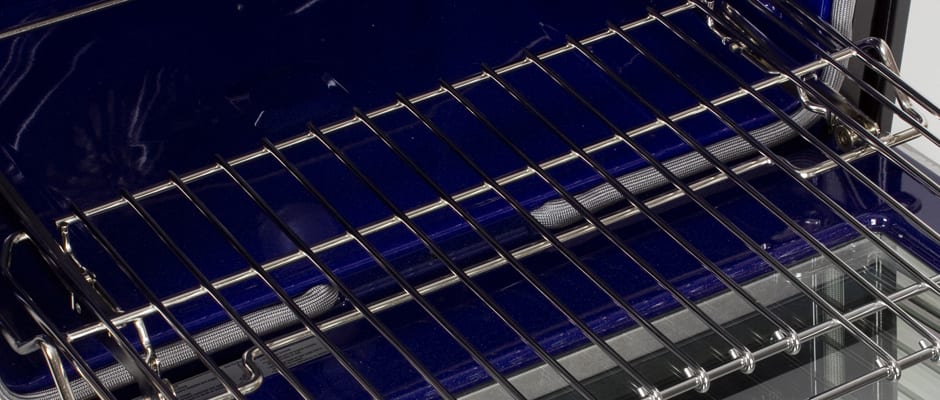Pros
Cons
Introduction
Well, the promise is fulfilled in some ways: the stainless finish (apparently requisite in all modern kitchen design), the commendable performance by the rangetop, the surplus of features, and the acceptable conventional oven. However, we found some serious problems with the lower oven in convection mode: notably the incredibly long preheating time and utter disregard for the target temperature. As most people consider the temperature setting an injunction rather than a suggestion, this performance may be a dealbreaker for some, as the second oven's functionality is called into question with the shoddy performance. And as convection ovens become more popular due to their superior performance and efficiency, many people might look elsewhere.
All in all, we found this oven to be a bit expensive for what it can do, but it would certainly be a decent buy for those who don't use convection cooking.
Design Overview
{{section_header}}{{section.name}}{{/section_header}}
A dual electric range with two ovens, the {{product.name}} has a 30-inch front with a thin stainless steel look. A bit more angular than its gas sibling the KGRS505XSS, it has a flat, ceramic top and the rear knobs. In comparison, this range seems a bit less monolithic—which is neither good nor bad, but does have a markedly different vibe. Of course, such are the diffferences between electric and gas. The two sturdy oven doors open up to show a strikingly blue interior with three racks, including a roller rack. As a freestanding range, there's a rear guard at the back, protecting the wall and housing the controls. All in all, a clean look, albeit boxy. Unfortunately, it's possible that some may find that it looks less expensive than it is.
Front
{{section_header}}{{section.name}}{{/section_header}}
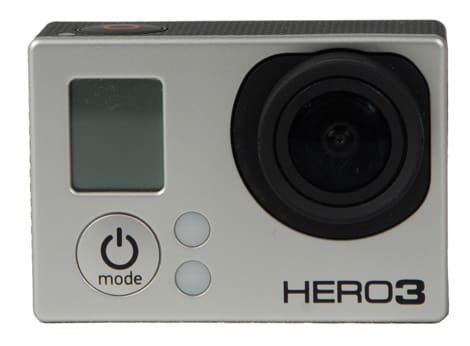
Range-top
{{section_header}}{{section.name}}{{/section_header}}
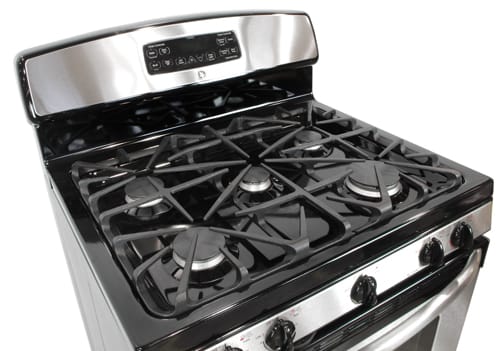
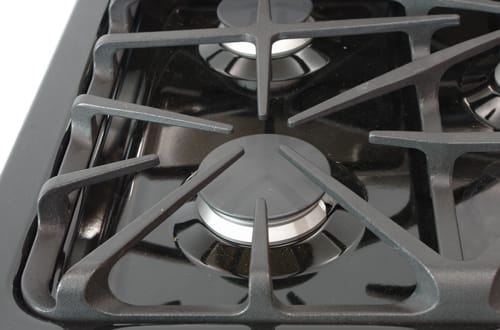
Upper Oven
{{section_header}}{{section.name}}{{/section_header}}
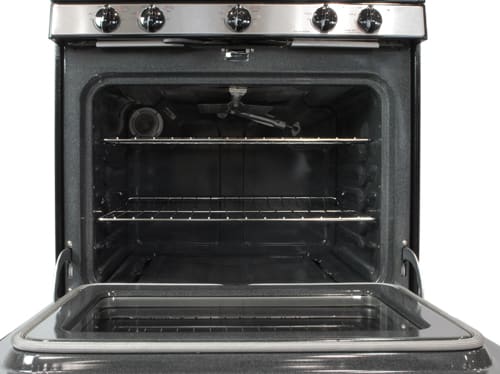
Lower Oven
{{section_header}}{{section.name}}{{/section_header}}


Broiler
{{section_header}}{{section.name}}{{/section_header}}
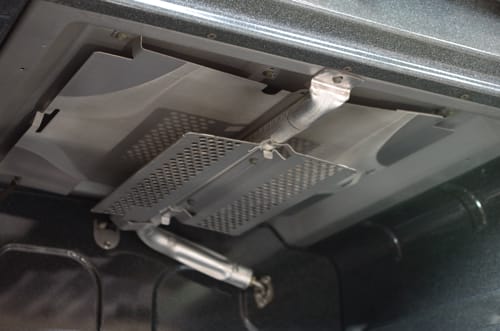
Cooking Performance
Our performance tests found strong results from the {{product.name}}'s rangetop on all four main elements. We noted boiling results in the all-around variety, with no stragglers nor standouts. The temperature range will accomplish both simmering and searing even without the panache of a blue flame. In the lower cavities, we found less satisfying results, especially in the lower oven's convection mode.
{{photo_gallery "Primary Oven Keep-Warm Ramp-up", "Primary Oven 350F Ramp-up", "Primary Oven Max Ramp-up", "Secondary Oven Convection Ramp-up", "Oven Temperature Variance", "Range-top Water Boil", "Range-top Temperature Range"}}
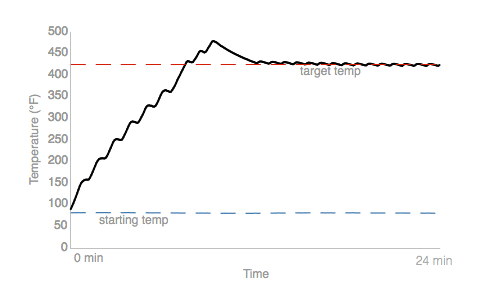
This is the upper divided cavity. After overshooting 425°F, it is ridiculously even.
Range Performance Overall
{{section_header}}{{section.name}}{{/section_header}}
The {{product.name}}'s four elements enclosed under the ceramic cook-top demonstrated strong results in all of our criteria. The depth of the rangetop, like a team, is perhaps its biggest strength, as any one of the burners would be good for almost anything. This rangetop is of course electric, which means that although you can't see any visual feedback after adjusting a knob—nor can the adjustment come instantaneously—you can enjoy a much higher temperature range.


Water Boiling
{{section_header}}{{section.name}}{{/section_header}}
The water boiling abilities are a good judge of pure energy transfer, and the {{product.name}} demonstrated it's a good energy middleman. The front right burner edged out the front left in the race to a boil, bringing six cups of H20 to 212*F in under nine minutes. The rear burners, surprisingly were not far behind. We often see one or two solid boiling elements with the rest underpowered, but the the left rear element managed to reach a boil in thirteen minutes. The smallest rear right burner—designed for simmering—outperformed normal simmering burners, boiling six cups of water in just twenty minutes.
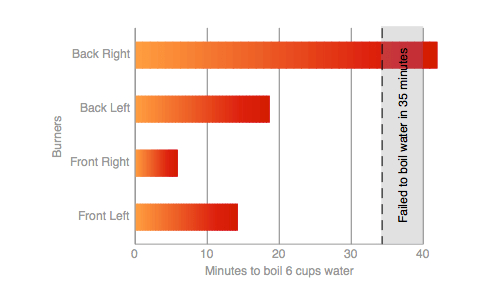
Don't try to boil with the back right simmer burner.
Low Temperature Cooking
{{section_header}}{{section.name}}{{/section_header}}
The lower end of the temperature spectrum managed to sink pretty low, as two elements on the {{product.name}} were recorded under 100°F: the front right at 95°F and the rear right at 95°F. The other elements weren't quite as good but still turned in very respectable results of 105°F and 127°F. Low temperatures are one of the major advantages of electric rangetops over their gas brethren, and the {{product.name}} doesn't waste the advantage.
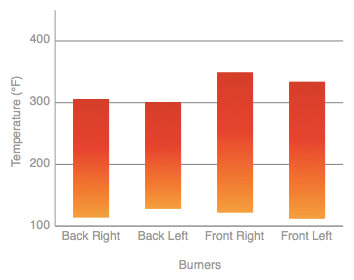
Maximum and minimum heat settings for each burner: The hottest burner reaches about 400F.
High Temperature Cooking
{{section_header}}{{section.name}}{{/section_header}}
This rangetop's upper bound of the temperature range is quite high, perhaps too high in the case of two elements, that go well above 700°F. Those elements (front right, rear left) should be used on their high setting with care and supervision. However, they will do very well for searing meat and other forms of high temperature cooking.
Overall Oven Performance
{{section_header}}{{section.name}}{{/section_header}}
The question of whether the {{product.name}} performs well isn't necessarily an easy one. We can easily say it's not the best we've seen, but it's not the worst either. The oven preheated to 350°F under eight minutes—a decent time—and to 500°F in twelve minutes. But when we came to temperature consistency, we recorded results that showed inconsistent consistency as the variance changed over the testing time. The bottom line seems to be that the conventional oven is decent, but monitor. As an old Hollywood man once said: trust but verify.
{{product.manufacturer_specs['Primary Oven Photo']}}{{photo_gallery "Primary Oven 350F Ramp-up", "Primary Oven Keep-Warm Ramp-up", "Primary Oven Max Ramp-up"}}
Target Temperature Accuracy
{{section_header}}{{section.name}}{{/section_header}}
The keep warm setting, although it was quite consistent, was a little higher than we'd have liked, but not unforgivably so by any means, only hitting 200°F for less than five seconds. We usually like to see an average twenty degrees lower than the 190°F we saw.
The oven's upper temperature bound was worthy of a new Dante level, reaching temperatures well into the 560's while averaging 547°F. This is probably getting close to the safe operating temperature for an oven, so you won't ever need anything hotter unless you are blowing glass or firing pottery.
Temperature Fluctuation
{{section_header}}{{section.name}}{{/section_header}}
The {{product.name}} maintained a rather funky temperature consistency in its conventional oven. The keep-warm setting stayed fairly constant, slowly declining from 200°F. It was fairly precise despite its inaccuracy, having lifted the mercury just a bit too high.
Set at 350°F, the oven kept on past its target temperature and fluctuated up to 363°F, then back down to 331°F, admirable variance. But the second fluctuation was a bit higher, with the temperature spiking up to 383°F. So it's not quite clear exactly how consistent the oven temperature consistency is, as the amount of fluctuation seems to vary. Set to the maximum temperature setting, the oven performs quite well for consistency, always staying close to the 550s.
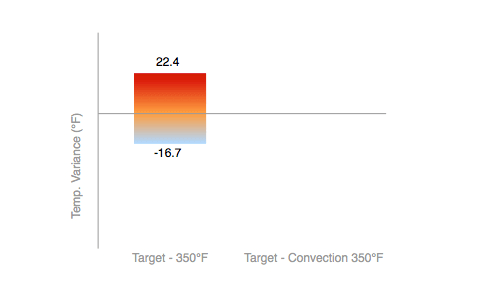
Oven "Margin of Error" in Temperature Variance: The oven is consistent at cool and mid-level temperatures, but inconsistent when operating at its warmest.
Secondary Oven Performance
{{section_header}}{{section.name}}{{/section_header}}
Interestingly, the {{product.name}}'s convection mode did poorly compared to the conventional mode. As the convection fans circulate the hot air around the oven, they often make it easier to maintain an even temperature. Unfortunately, this was not the case, as the very slowly preheating lower cavity reached 350°F at the tortoise-like speed of eighteen minutes. After the leisurely stroll to this target temperature, the oven elected to continue its travels up to 389°F, tarrying around up there for a bit before cooling off slightly. This abject lack temperature control is completely unsatisfactory and your food will return its poor treatment to you on your taste buds.

This is the upper divided cavity. After overshooting 425°F, it is ridiculously even.
Broiler Performance
{{section_header}}{{section.name}}{{/section_header}}
Broilers are located in both the upper and lower oven cavities, allowing for impressive quantities of meat and vegetables to be grilled. The manual recommends broiling with the door open, presumably so radiant heat can be the chief means of cooking rather than the convection heat from the air within. The broiler reached 600°F very quickly, in seven minutes. Fortunately, you needn't wait that long to put in your food. A few minutes preheating will do.

Broiler Features
{{section_header}}{{section.name}}{{/section_header}}
The broiler on the {{product.name}} has a rather unique feature, the adjustable broiler. Instead of the typical one or two settings "HI" and "LO," this broiler allows for more fine tuning. While this may not be particularly useful in comparison, it's always nice to have the choice.
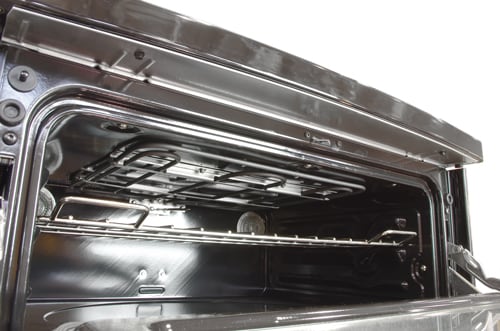
Overall Efficiency
{{section_header}}{{section.name}}{{/section_header}}
The overall efficiency is difficult to calculate, as it's hard to know how much energy an oven wastes. The issue is further complicated when you consider there isn't an Energy Star rating for home ovens. Fortunately, there are other ways with which we can try to nail this down.
Range Efficiency
{{section_header}}{{section.name}}{{/section_header}}
The range boasted strong boiling abilities across the board, with the weakest simmer burner making our twenty minute mark with six cups. It seems that for a rangetop of 8003 watts, the {{product.name}} puts them all to good use, wasting very little.
Oven Efficiency
{{section_header}}{{section.name}}{{/section_header}}
Since the moderate performance from the oven elements didn't blow us away, we didn't necessarily expect a large power draw. The very slow preheating lower cavity (read: underpowered) seems to match right up to the amount of power it draws on the convection setting: 3700 watts. This doesn't seem particularly good to us, and we imagine some energy is wasted. The smaller, upper oven seems more efficient, turning out better results with its fewer watts (3681). Naturally, it follows as less area to heat means less waste, unless you require larger capacity, which isn't every day.
Features
{{section_header}}{{section.name}}{{/section_header}}
Besides having four elements that performed well in our boiling tests, the range has some additional features that could prove useful in the kitchen. On the front left burner, there are not one but three different elements designed to accommodate various sizes of stoveware for the most even heating. The fifth element (no, not the sci-fi film by Luc Besson) is a keep-warm burner in the center of the range, serving as the greenroom for food waiting for the table.

The range's chief oven feature is, well, the fact that it has two of them. Bakers and roasters alike will appreciate the vast capacity of the 2.5 cubic foot and 4.2 cubic foot upper oven, offering a 6.7 combined cubic feet, programmable at two temperatures or the same one. The lower oven boasts an "EasyConvect" convection system. Unfortunately, we found this mode to be far inferior to the upper oven's conventional performance. This is too bad, as convection ovens that work properly can cut necessary temperature, cook time, and provide more even heat.
Additional features include sturdy oven racks—one of which rolls out providing especially easy access to the food—and a slow-cook setting that has low temperatures allowing for four, eight, and twelve hour sauna session for food that takes its time.
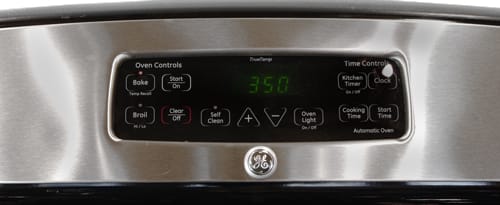
This is a fairly straightforward timer, but it's set by a keypad rather than counting up, making it necessary to start over if you press a wrong button.
{{product.manufacturer_specs['Timer Photo']}}
Controls
{{section_header}}{{section.name}}{{/section_header}}
Like many electric ovens, the rangetop controls on the {{product.name}} are unfortunately located on the splash guard to the rear of the range. This necessitates the obnoxious and possibly painful task of reaching over boiling liquids to make adjustments. And of course, due to its electric-ness, controlling the range precisely is more difficult due to the lack of flame, so you may be reaching over frequently to adjust.
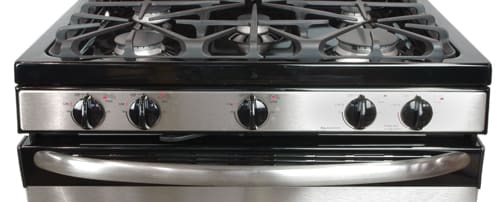
The intuitive oven is easy to control via the rear control panel. Simply press a button, select the temperature, and start it up. All without the annoyance of convoluted menus.

The broiler is operated much as the oven is: with the simple push of the "broil" button and then the "start" button. Between those two steps, or even after, you can still adjust the temperature at your convenience.
{{product.manufacturer_specs['Broiler Controls Photo']}}
Cleaning
Conclusion
{{product.vanity}}
For $1,750 (MSRP $2,000), {{product.name}} comes with two ovens, five burners, and a character as flawed as Harry Callahan.
Under the smooth ceramic top, the rangetop elements performed quite well. Often we see all of the power placed on one boiler, but here we found three well-powered elements, and even the simmering burner could boil pretty fast. The elements' heat range was excellent as well, with equally good simmering and searing abilities.
Down below, we were less satisfied. The upper conventional oven performed fine—although it was a was a little odd at 350°F—but the lower convection oven did not impress. Lacking a fast preheat, accuracy to the target temperature, or precision of temperature, our tests of this oven make it simply seem unusable. Even if this lower oven was adequate, we'd probably consider this a few hundred dollars too expensive.
Since we expect someone in the market for a dual oven range to want to use the features they've bought, we hesitate to recommend this range, as the convection oven was so impotent. Convection cooking has so many advantages, and it seems silly to shell out for something that wouldn't necessarily be used. Sure, this range might work if you know you the convection oven will never be touched—though we might advocate waiting for the price to drop more. But if you even think you might want to convect, move on.
Meet the tester
Ethan writes reviews and articles about science for Reviewed.com, and edits the Science Blog. He's originally from Vermont and thinks the bicycle and guitar are examples of perfected technology. Prior to Reviewed.com, he studied furiously at Middlebury College.
Checking our work.
Our team is here to help you buy the best stuff and love what you own. Our writers, editors, and experts obsess over the products we cover to make sure you're confident and satisfied. Have a different opinion about something we recommend? Email us and we'll compare notes.
Shoot us an email